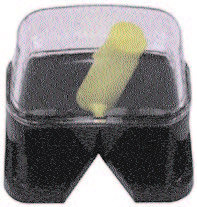FEATURES:
- Plastic browsing sled
- Magnetic toggle
- Warranty: n/a
If you’re looking to attach a bookshelf or cabinet or anything you care about to your wall, you’ll need to find anchorage for your mounting screws in an upright two-by-four stud. Connoisseurs of disaster may rely on the load-bearing competence of drywall screws and anchors, but if you would like the thing you’re attaching to the wall to stay attached, you’ll want to spend a moment prospecting for sturdy pine.
Before hanging my bookshelf, I went out and spent $3 on a magnetic studfinder made by the Stanley Corporation. It is a simple thing: a small cylindrical magnet sheathed in a yellow plastic harness which toggles on its vertical axis beneath a transparent dome. The dome and the harness are fixed to a black plastic browsing sled, smooth-bottomed so you can scoot it easily across wallboard while it does its work.
The studfinder’s toggling magnet is not actually interested in finding studs. Rather, it has a specific affection for the nailheads hidden beneath the paint, and the toggle will quiver with interest when you steer it over one. You hope, of course, that the studfinder is stirring because of a nail that is tacking the drywall to a stud, but any strays or accidentals will also set off tremors in the toggle, which is one of the magnetic studfinder’s frustrating delicacies. Furthermore, the studfinder performs poorly on imperfect wallboard; any keloid drabs of spackle, kernels of grit magnified by years of accreted paint, or tiny umbilications in the plaster will jostle the toggle and send it quaking in error.
After several minutes of “seshing” with the thing I still hadn’t found a spot where the toggle would yaw with any real conviction. I drilled sprays of pilot holes and felt only the brief, collapsing resistance of the wallboard and then a great nothingness. I paid a visit to my upstairs neighbor to talk about the problem. He is a former cheerleader, and he is one of the toughest, most capable people I know. He has been punched in the face so many times that the flesh around his eyes looks like sweetgum bark. I slid the studfinder around the wall for him and showed him the pilot holes. “You see?”
But my neighbor wasn’t interested. He picked up one of the wooden brackets I had made for my bookshelf: a 90-degree brace made of 1x2s with another mitered piece connecting the two legs. He seized the brace by the hypotenuse and clapped it against his hip like a tambourine. “I’m gonna tell you,” he said. “I watched you out on the porch messing around with your saw, and...
You have reached your article limit
Sign up for a digital subscription and continue reading all new issues, plus our entire archives, for just $1.50/month.
Already a subscriber? Sign in





